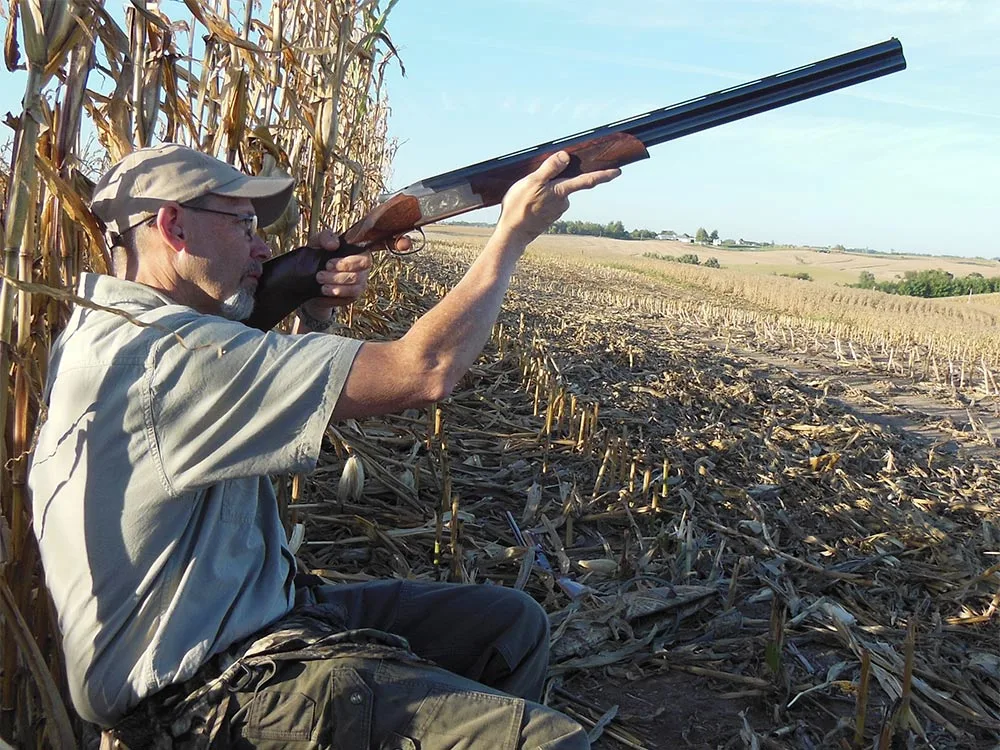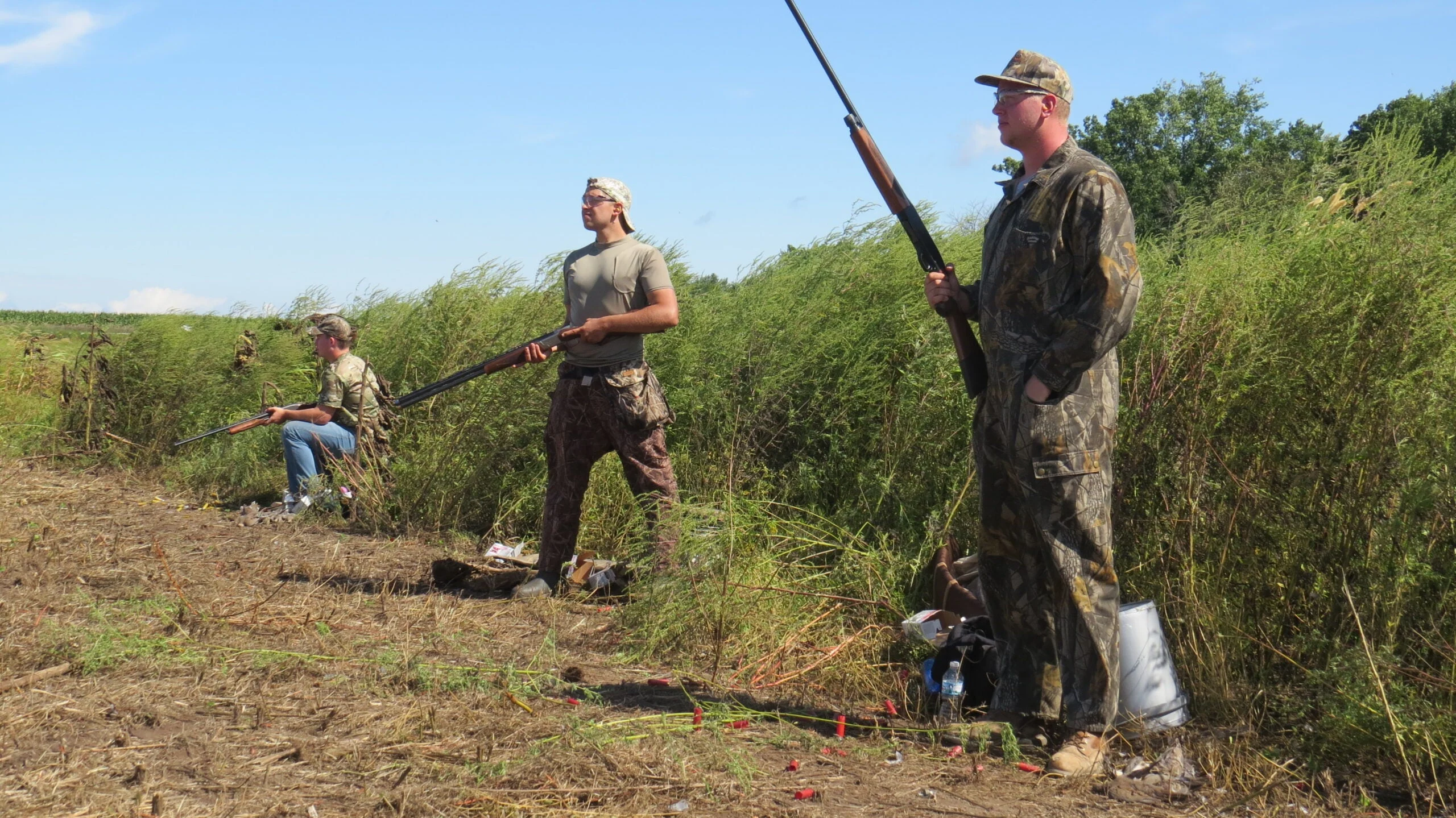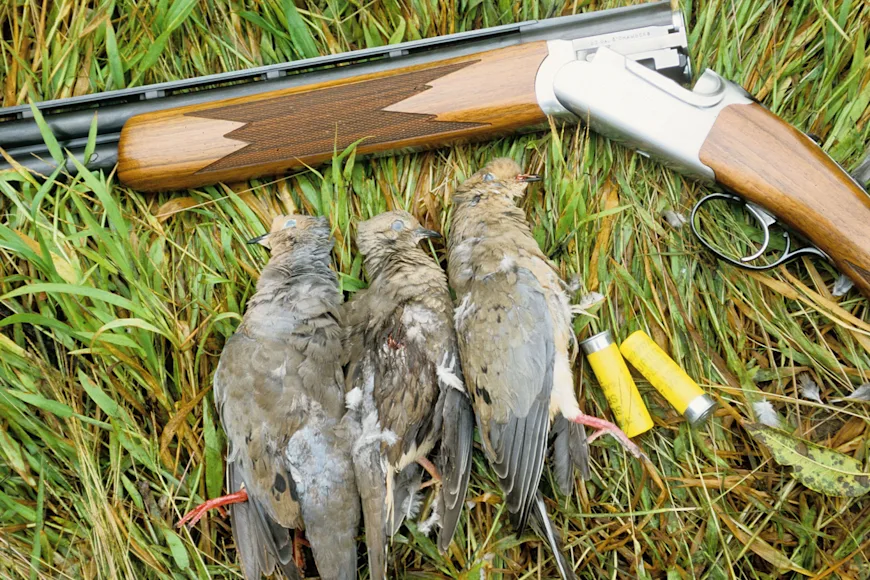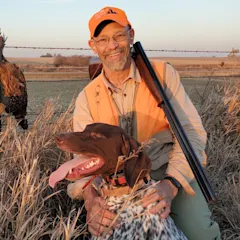Dove hunting kicks fall seasons off with a big bang. And while there is no better way to warm up for later bird seasons than with a hot dove shoot or two, dove hunting is well-worth pursuing in its own right. Dove hunting will test your shooting skills, and, if you’re a freelance hunter, your scouting and permission-getting skills as well.
And, it’s fun. The weather is warm. Dove hunting isn’t physically demanding. You see hunting friends you may not have seen much over the summer. Sometimes there’s a barbecue after the hunt. Doves are tasty. It’s all good, and if you’re not dove hunting, you need to be. Here’s how to get started.
Table of Contents
The Types of Doves You Can Hunt
Where to go Dove Hunting
Dove Hunting 101
Dove Hunting Decoys
Dove Guns and Loads
How to Clean and Cook a Dove
The Types of Doves You Can Hunt
Mourning Doves
There are four huntable species of doves in North America. By far the most common, numerous, widespread, and important to hunters, is the mourning dove. Mourning doves are legal game in 41 states. They’re our most popular gamebird and the dove you see at your feeder and hear cooing in the summer. They are early migrants, often moving on the slightest cold front, although some mourning doves will stay around and winter in some very cold places. Like all doves, mourning doves are seed-eaters, preferring to feed on fairly open ground where they can spot danger as they walk around looking for food.
White Wing Doves
Native to the southwest, white-winged doves are larger than mourning doves and identifiable by the white bands on their wings. Most white-wing hunting in the United States takes place in Texas, although the birds do spread east and west during their migration.
Eurasian Collared Doves
A recent, invasive arrival, Eurasian collared doves are bigger than mourning doves and have a black collar on the back of their necks. You’ll find them in the same places you hunt mourning doves, although they rarely get too far away from towns or farms. Some states allow year-round hunting for Eurasian collared doves with no bag limit. In other states, they are legal only during mourning dove season and form part of an aggregate bag limit.
Pigeons
Pigeons (actually “rock doves”) are another invasive that has made themselves very much at home. They, too, can be hunted like doves, often near livestock operations, and they are occasional visitors to the dove field as well. Most places treat them as unprotected and allow year-round shooting, but check state regulations.

Where to Go Dove Hunting
Most dove hunting takes place in fields where the birds are coming to feed. Those fields are often public or private sunflower plots mowed to attract doves. They can also be ag fields. Corn, canola, hemp, wheat, even alfalfa, and melon fields all can offer good dove hunting once they are all or partially cut or harvested.
The right water hole, near a feed field with bare banks and maybe a dead tree or two nearby, can be a great place to sit in the last hour of daylight before doves go to roost. Likewise, if you can find a roost, you can enjoy 20 to 30 minutes of frantic shooting at the very end of the day.
Unless you are invited to a private field, in which case you show up and sit where you’re told, you’ll have to scout to find birds. Cold fronts move old birds out and new birds in. As different ag fields open up, doves find them. Not all public fields attract doves equally, either, as sunflowers are tricky to grow, and not all dove food plots are created equal. In the days before the season opens, get out and watch birds to see which fields the birds are using.
If you’re out prospecting for a private spot, the best way to find doves is to look for them on power lines and in dead trees near feed fields. Later afternoon is usually a good time to look. If you see ten doves together, it’s a very good sign. If you see twenty sitting on a wire together, that’s as close a sure thing as you’ll find in dove hunting.
Once you find a field, watch it to see which parts doves prefer. Figure out where they enter the field, where they leave, and where they want to land. Check potential watering holes in the last hour of daylight when doves use them, and you might be able to figure out where they roost if you can see where they go after getting a drink.
For a lot of hunters, “dove season” means the first day or two of the year, before the heavy hunting pressure burns out the public fields. If you can stay on top of the birds with scouting, and you can get onto private land or find lightly-hunted public dove plots, you can have very good hunting for weeks, not just two days.
Dove Hunting 101
Most dove hunts take place either in the morning, with shooting hours beginning half an hour before sunrise, or in the afternoon, as doves usually feed late in the afternoon up until about an hour before sunset when they go to water. However, one way to beat the crowds at a public field is to wait until mid-morning when most people have left and the afternoon hunters haven’t yet arrived. The shooting is nowhere near as fast as it is first thing in the morning, but you’ll have the field mostly to yourself. You can move around if need be, and any shots you do get will be all yours—with no competition from other hunters.

Once you’ve found doves—or been invited to a dove field—all you have to do is shoot straight and be safe. You’ll want a bucket or a folding chair to sit on, drab or camo clothes to keep you inconspicuous, and something to hold water and at least three boxes of shells. Dove hunting is a matter of pass-shooting or of shooting decoying birds. In either case, it would have been a good idea to shoot plenty of skeet and sporting clays over the summer to get ready.
Whether or not you’ve practiced, focus on the head or front end of birds, think about matching your gun speed to the bird’s speed, and do your best to take only good, safe shots inside 30 yards. It’s tempting, especially when dove hunting is new to you, to empty your gun at every bird that flies by. All that does is waste shells and increase the chance that your gun will be empty when an easy shot presents itself.
Dove fields can be crowded, and sometimes there will be shooters across from you. In that instance, only take shots when you can see sky underneath the bird, and be careful not to swing too far to either side, either. Earplugs are a necessity to protect your hearing, and shooting glasses that can stop a pellet are a good safety precaution.
Dove Hunting Decoys
Decoys bring doves in for good, close shots and, for those who like watching birds come to a decoy, make dove hunting even more fun. Decoys aren’t always allowed in some fields because they increase the chance of low shots, but any time you can use them safely, you should.
Old-school dove decoys clip onto trees, fences, or wires and they can work. Spinning-wing decoys, however, make the old kind virtually obsolete. One or two spinners set 15 to 20 yards from your bucket will bring doves close. Often, they will land next to the decoy and dove hunting becomes a lot more like a dry field duck hunt.
Dove Hunting Guns and Loads
Any gun can be a dove gun, and if one of your goals is getting ready for fall seasons, shooting your regular hunting gun is a good idea. Equip it with an Improved Cylinder choke, and load it with either lead 7½ or 8 shot or steel 6 or 7, any of which contains enough pellets to give a pattern that’s dense enough to make multiple hits on a small target like a dove. Any gauge, from 12 on down, can be a dove gun. If you choose a .410, you will have to be very careful in your shot selection as there aren’t many pellets in a .410 load the guns pattern poorly.
The ideal dove gun for most people is probably a 20-gauge gas semiauto, a gun that sends enough shot to take doves cleanly to 30 or more yards, and with very little recoil. Because dove hunting is primarily a pass-shooting hunt, a 28-inch barrel helps the gun to swing smoothly. And, while some shooters prefer O/Us, the truth is, if you learn to hold that third shell in reserve, you’ll get chances O/U shooters miss out on because their guns are broken open to reload at the wrong time.

How to Clean and Cook a Dove
Doves are tiny but tasty. The breasts are dark red meat that tastes like beef, or like little duck breasts, if you cook it rare. Breasting a dove is simple and takes seconds, leaving you with about an ounce of meat per dove. You can leave the meat on the keel and make the ever-popular dove popper, a cream-cheese and jalapeno-stuffed breast wrapped in bacon, or you can filet those two bites off the breast and use them in a kabob or stir-fry. And, again, the meat will be delicious rare, and unpleasantly liver-like if you cook it too much.
Read Next: Squirrel Hunting: The Ultimate Guide to Chasing Bushytails
Picking your doves is an option, too. It takes only a couple of minutes to pluck the whole bird, cut off the wings at the first or second joint and pull out the entrails and pull off the head. From there, split the bird in two up the back and along the keel, grill it or broil it briefly, and enjoy. Whichever way you cook your doves, chances are high that you will a), eat them all and b). want more, which means you get to go dove hunting again.


